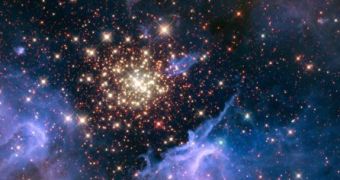Newly released photo taken by the Hubble Space Telescope, caught an accumulation of stars in what looked like a dazzling fireworks show. It shows a nebula 20,000 light-years away in the Carina constellation, containing a central cluster of enormous hot stars called NGC 3603. It is surrounded by clouds of interstellar dust and gas; everything needed to form new stars is there.
The environment seen in the picture is quite volatile, as ultraviolet radiation and violent stellar winds have blown a huge cavity in the bubble of gas and dust enveloping the cluster. The image of the cluster's heart was actually taken between August and December of last year, but was released on Tuesday. These star clusters provide extremely valuable information that helps scientists understand the origin of massive star formation at the beginning of the Universe.
Even if the stars in this cluster differ in size, mass, color and temperature, they were all born at the same time. Star clusters allow stellar cycles to be analyzed as they contain stars in various stages of their life. More of the most massive stars known are contained in the NGC 3603. these stars live fast and die young as they rapidly burn through their hydrogen fuel. They end their life in a spectacular supernova explosion.
Massive star clusters can also be used by astronomers to study distant starbursts that take place when galaxies collide. These impacts set off a stirring mass of star formation, and the proximity of NGC 3603 makes it an interesting study for the examination of such events.
The image of NGC 3603 was captured by Hubble in August 2009 and December 2009 with the telescope's Wide Field Camera 3 in both visible and infrared light. The Hubble Space Telescope was launched in 1990 aboard a NASA space shuttle and been overhauled several times by astronauts on later flights. It has been observing the universe ever since.

 14 DAY TRIAL //
14 DAY TRIAL //